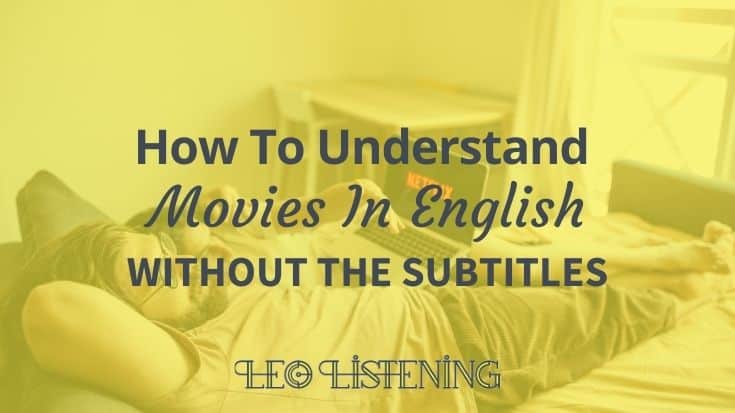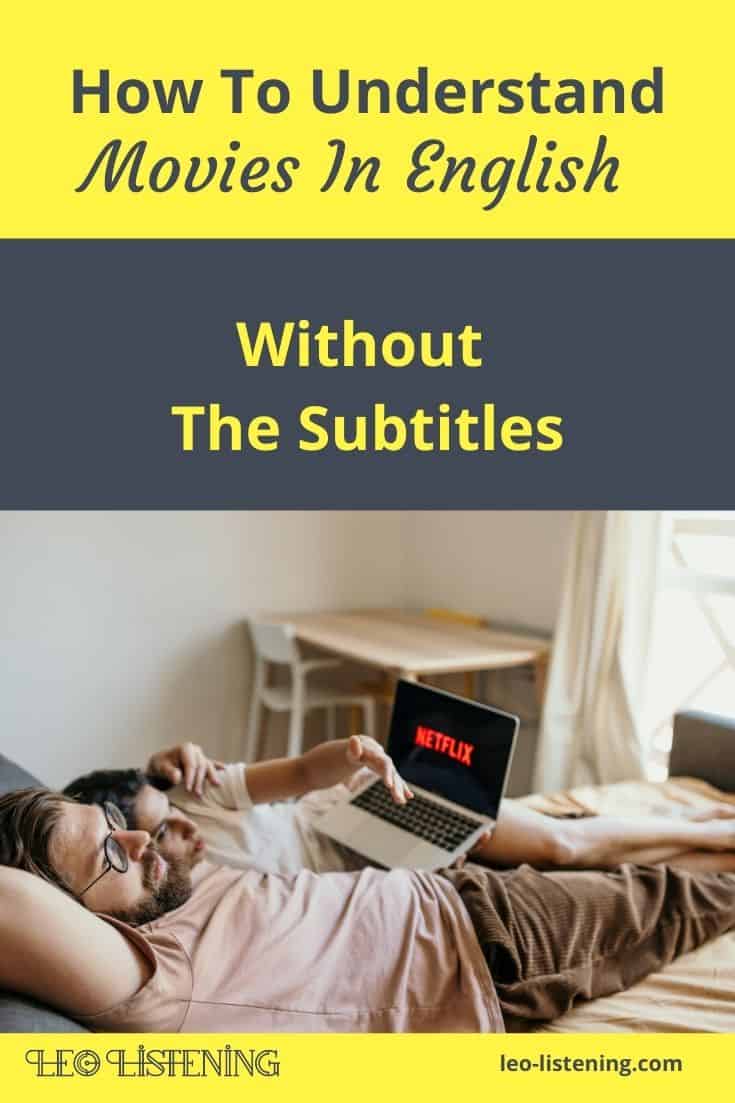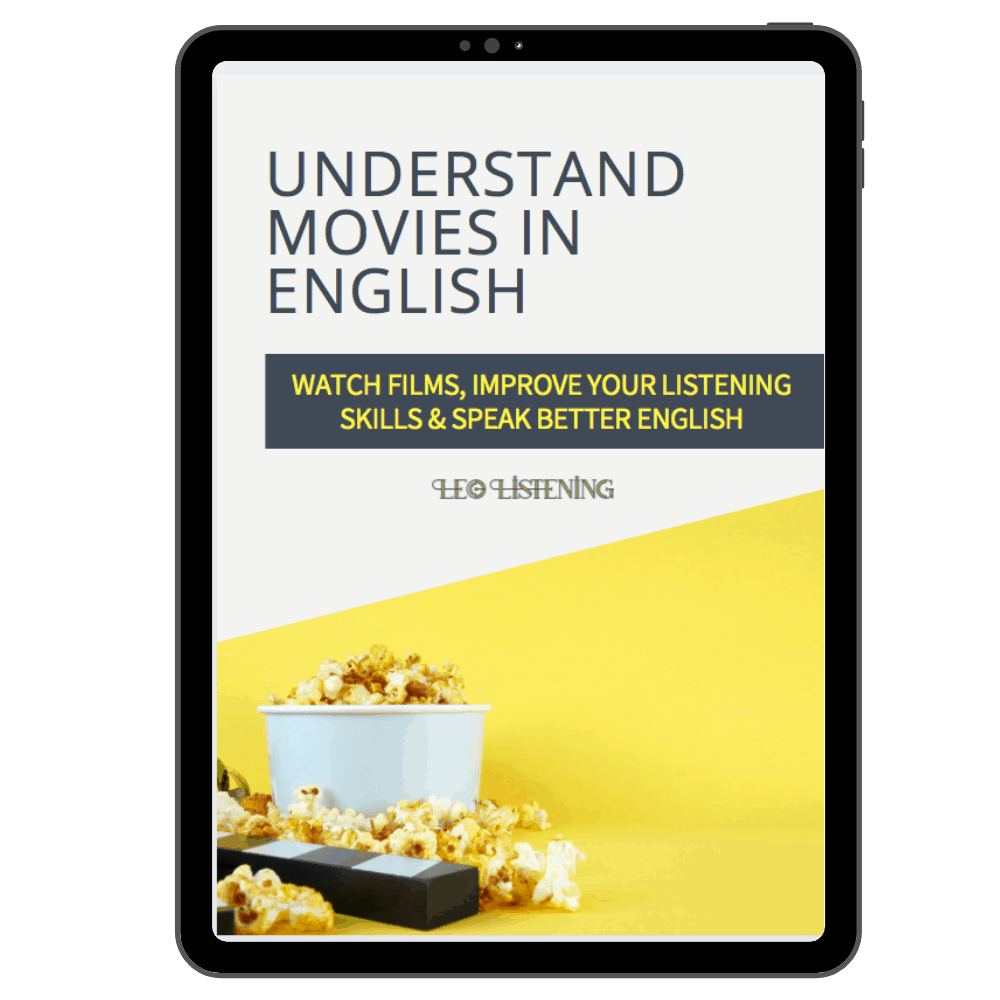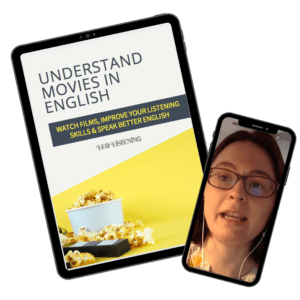3 Simple Steps To Understand Movies In English Without Subtitles

Updated September 2022.
How to understand English movies without subtitles – if you’re asking yourself the question, then congratulations!
You don’t need to feel bad if you’re watching movies or TV series with subtitles.
It’s already fantastic that you’re watching them in English.
TV is a way for many of us to relax, not study. So congratulate yourself: you’re doing something that you love and improving your English at the same time.
Now you’re feeling a bit better, what can you do to start transitioning away from subtitles? And how can you get rid of them completely?
It’s not you, it’s them
Have you heard the expression it’s not you it’s me? It’s one of those cowardly lines people say when they want to dump their partner.
What’s this got to do with not using subtitles when you watch TV or films in English?
Think about it for a second – could it be that it’s not you, it’s them?
4 Reasons Why You Don’t Need To Feel Guilty About Needing Subtitles
1.Excuse me?
Are you watching TV series or films that are too complex for you? Not too long ago I watched Robocop. I missed a lot of the dialogue in the opening scenes because it was fast and mumbly. I had to really concentrate to pick it up. And I’m a native English speaker!
2. I don’t get it
Think about the types of TV programme people like to watch. Sitcoms are tricky because they’re full of one-liners, wisecrack jokes and other witticisms. Some of these can include plays on words, which are tricky to understand, even with the subtitles.
And if you’ve ever watched sitcoms with the subtitles in your native language, you’ll know that translators don’t always get the joke. I’ve seen that many a time with the fan subtitling (fans of the show create the subtitles) of How I Met Your Mother.
3. Whooooooooo?
2 words: Gilmore Girls. I know you know them – it’s one of the best TV series of all time! (if you don’t know what I’m talking about, don’t worry, there’s a video coming up!
The girls, both called Lorelei, speak at a million miles per hour (must be all that coffee they drink). And they’re constantly referring to politicians, musicians and old American movies. Confession: as a British person, I don’t understand all the references!
In one episode they decide to get a dog. Dog’s name: Paul Anka. Yes, the dog has a first and last name. The first time I heard what I now know to be the name ‘Paul Anka’, I was like – they called the dog what? Polanker? Paul Anchor? What on earth are they talking about?
If you’re reading this then English is probably not your native language. You have to catch the person’s name in fast speech. And, even if you do, you might not have the cultural knowledge to understand the reference.
Once again, it’s not your fault!
By the way, a quick Google search reveals that Paul Anka is a Canadian-American singer-songwriter. But you’re not going to interrupt a show to check Google are you?
4. Is this the real life?
A lot of dialogue in TV series is pretty far removed from real life.
Think of the characters politely taking turns in Game of Thrones (GoT). We’re talking about arch-rivals for the iron throne, people with grudges and resentment going back to the time of the mad king. (I warned you – I love TV shows! Again, if you don’t know what I’m talking about, a video is coming – that’s also a GoT reference – nevermind!)
- they never overlap or interrupt each other.
- they never have to formulate or repeat.
- they never ask each other for clarification.
But in real-world in conversations, repetitions, clarifications and reformulations help you understand better.
They give you precious thinking time to catch up with everything you’ve just heard.
Watch arch-enemies Ned Stark and Cersei Lannister take turns nice and neatly.

How To Understand English Movies Without Subtitles: 3-Step Plan
Step 1: Choose a series that deserves you
Your ultimate aim should be enjoyment. Watching films and TV series is one of the most fun things you can do!
Narrow it down. Which series do you really want to understand? Concentrate on this one to start off.
- one TV show
- one season
- one episode at a time
It takes time to get used to someone’s voice. This probably explains why TV series are more manageable than films. You watch the same characters week in, week out.
A tip for choosing TV series: choose one where there aren’t too many characters or the characters don’t get killed off every episode. I would avoid “The Walking Dead” for instance or even “The Americans”, where many new characters are introduced, only to be killed-off shortly afterwards!
If you’re more of a film buff, you could look for films by the same director or with the same actors. The same actors generally appear in Wes Anderson’s films.
- Still too much? If so, maybe start with another type of TV programme. Instead of a sitcom filled with one-liners, word play and obscure references, go for a reality TV show. You could even try a series intended for kids. Or maybe something more intellectual like a documentary.
- Another great option is Soap Operas. Why? Because they film episodes constantly, week in, week out. Some TV series, like Game of Thrones, only have ten episodes. And each episode is 45-50 minutes long. Unless you wait and binge-watch several seasons in one go of course, which could be amazing, but completely overwhelming.
- The Internet is becoming more and more video based. 20-minute sitcom episodes or 45-minute drama episodes are not the only way to watch in English. My colleague, Cecilia Nobre, wrote a post for teachers on how to use video in the classroom. She gave examples such as:
-
- Video section of Facebook fanpages – she recommends BBC Culture, Entrepreneur or CNN.
- Facebook live videos
- YouTube vlogs
Step 2: Use the subtitles, the right way
So, you’ve chosen 1 series or film director you’re going to concentrate on. Or simply a shorter video.
Now, how do you start getting rid of those annoying subtitles?
Use them, but after the fact.
Start by choosing a scene – just one scene. Not the whole episode and certainly not the whole film. Listen and try to write down what you hear, what you think is going on. You can repeat this several times.
I know this is not quite how you envisaged relaxing in front of Netflicks of an evening, but stick with it, it’ll be worth it.
After, go back in and listen with the subtitles on and figure out what you missed. You’ll get some feedback on your problems this way.
- Did you misunderstand a word?
- Were there problems due to connected speech?
- Were there too many new words and expressions?
- Was there some kind of cultural reference you didn’t understand?
As you do this, you’ll start to build up a picture of your difficulties.
- If you’re watching Game of Thrones in English, maybe some of the vocabulary to do with warfare and weaponry is causing you problems.
- If you have a preference for sitcoms, then some of the jokes may contain cultural references you’re not aware of.
- Maybe your problem is catching all of the little details like pronouns, articles, or auxiliary verbs.
- If you want to understand a reality TV show, maybe some of the real life vocab, slang and phrasal verbs is proving problematic.
You can’t understand where your difficulties are coming from until you diagnose them.
Some of these problems may resolve themselves as you watch the show more and you become familiar with the vocabulary.
Some may require some more focused listening work.
In some cases, you may need to take your listening down a notch and find a series that’s less tricky for you.
At the very least, you’ll have a plan of attack moving forward.
3. A question you need to ask yourself
How much is enough?
If you can understand 80-90% of the series, do you really need to push through to 100%? That’s already a high level of understanding.
TV series have the visual element to accompany them and perhaps that will be enough to push your understanding through. Maybe you won’t have to turn those subtitles back on again.
Once you’ve gone through a few cycles of choosing shows and then analysing them to figure out where your comprehension difficulties are, you can start turning the subtitles off.
You can do this gradually. You could start by watching the show in your language and then re-watch it in English with and then without subtitles.
You can make this process more complex, gradually removing the steps.
For example, go straight into the English version with English subtitles, rather than watching dubbed into your language or with subtitles in your language. As you gradually remove these elements, you’ll get closer to being able to watch from the first viewing 100% in English.
But you have to accept that it’s a process. You can’t expect to watch everything without subtitles in the beginning, but you can get there.
How To Understand English Movies Without Subtitles: A Summary
- Choose the right type of film or show. Accept that you may have to come down a level (shorter videos, videos with just one speaker) before you can watch what you really want to watch without subtitles.
- Focus on just one show, one episode, one scene.
- Use subtitles after the fact, as a way to check your understanding.
- Transition gradually away from subtitles in your language, to subtitles in English to watching with and without subtitles and so on.
Are you trying to watch shows and films in English without subtitles? What has worked for you so far? Let me know in the comments.
Subscribe To My Newsletter To Get Your Free Guide
Want to use your favourite movie or TV show to understand native English speakers when they talk fast? Download your free guide, Understand Movies in English.



Hi Cara,
Yes! Reality shows are a good choice because of those “real life dialogue” aspects that you talked about. To paraphrase you here, in reality shows:
They DO sometimes overlap or interrupt each other.
They DO have to formulate or repeat.
They DO ask each other for clarification.
So much more like real conversations. Although edited and sometimes with music in the background for emphasis.
Sabrina
Hi Sabrina. Thanks for your comment. Reality TV shows are a tip I got from Leandra. She used them to improve her conversational French. I’ll need to make a list for a future blog post. Even though we know some “reality” shows are fake, the dialogue is generally conversational and spontaneous. The only non-conversational bits are the talking heads sequences they record in the studio and any voiceovers.
Nice! I’m looking forward to seeing which reality shows you recommend for learners.